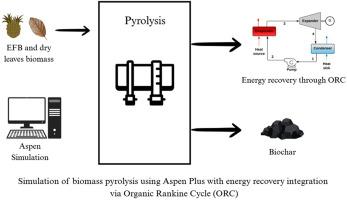Integrating dry leaf combustion with palm empty fruit bunch pyrolysis for biochar production and energy recovery: An Aspen Plus model
IF 5.8
2区 生物学
Q1 AGRICULTURAL ENGINEERING
引用次数: 0
Abstract
This study presents a simulation-based design of a continuous pyrolysis system for converting palm empty fruit bunches (EFB) into biochar, using dry leaves as a renewable heat source. Modeled in Aspen Plus, the system incorporates customized yield prediction models, RYield reactors, and an integrated Organic Rankine Cycle (ORC) for energy recovery. The model was validated against experimental data (R2: 94.9 %), and simulation results show that pyrolysis temperature significantly affects product distribution, with bio-oil yield peaking at ∼400 °C. The system achieves an energy efficiency of 67.94 %, with an estimated annual CO2-equivalent avoidance of ∼1.08 tons per unit. This approach demonstrates the potential of decentralized biomass systems for rural energy generation and carbon sequestration. Future work will focus on optimizing thermal efficiency through enhanced ORC integration.

结合干叶燃烧与棕榈空果束热解生物炭生产和能量回收:一个Aspen Plus模型
本研究提出了一种基于模拟的连续热解系统设计,该系统将棕榈空果束(EFB)转化为生物炭,使用干叶作为可再生热源。该系统在Aspen Plus中建模,结合了定制的产量预测模型、RYield反应器和集成的有机朗肯循环(ORC),用于能量回收。模型与实验数据进行了验证(R2: 94.9%),模拟结果表明热解温度对产物分布有显著影响,生物油产率在~ 400°C时达到峰值。该系统实现了67.94%的能源效率,估计每单位每年可减少约1.08吨的二氧化碳当量。这种方法显示了分散的生物质系统在农村能源生产和碳封存方面的潜力。未来的工作将侧重于通过增强ORC集成来优化热效率。
本文章由计算机程序翻译,如有差异,请以英文原文为准。
求助全文
约1分钟内获得全文
求助全文
来源期刊

Biomass & Bioenergy
工程技术-能源与燃料
CiteScore
11.50
自引率
3.30%
发文量
258
审稿时长
60 days
期刊介绍:
Biomass & Bioenergy is an international journal publishing original research papers and short communications, review articles and case studies on biological resources, chemical and biological processes, and biomass products for new renewable sources of energy and materials.
The scope of the journal extends to the environmental, management and economic aspects of biomass and bioenergy.
Key areas covered by the journal:
• Biomass: sources, energy crop production processes, genetic improvements, composition. Please note that research on these biomass subjects must be linked directly to bioenergy generation.
• Biological Residues: residues/rests from agricultural production, forestry and plantations (palm, sugar etc), processing industries, and municipal sources (MSW). Papers on the use of biomass residues through innovative processes/technological novelty and/or consideration of feedstock/system sustainability (or unsustainability) are welcomed. However waste treatment processes and pollution control or mitigation which are only tangentially related to bioenergy are not in the scope of the journal, as they are more suited to publications in the environmental arena. Papers that describe conventional waste streams (ie well described in existing literature) that do not empirically address ''new'' added value from the process are not suitable for submission to the journal.
• Bioenergy Processes: fermentations, thermochemical conversions, liquid and gaseous fuels, and petrochemical substitutes
• Bioenergy Utilization: direct combustion, gasification, electricity production, chemical processes, and by-product remediation
• Biomass and the Environment: carbon cycle, the net energy efficiency of bioenergy systems, assessment of sustainability, and biodiversity issues.
 求助内容:
求助内容: 应助结果提醒方式:
应助结果提醒方式:


